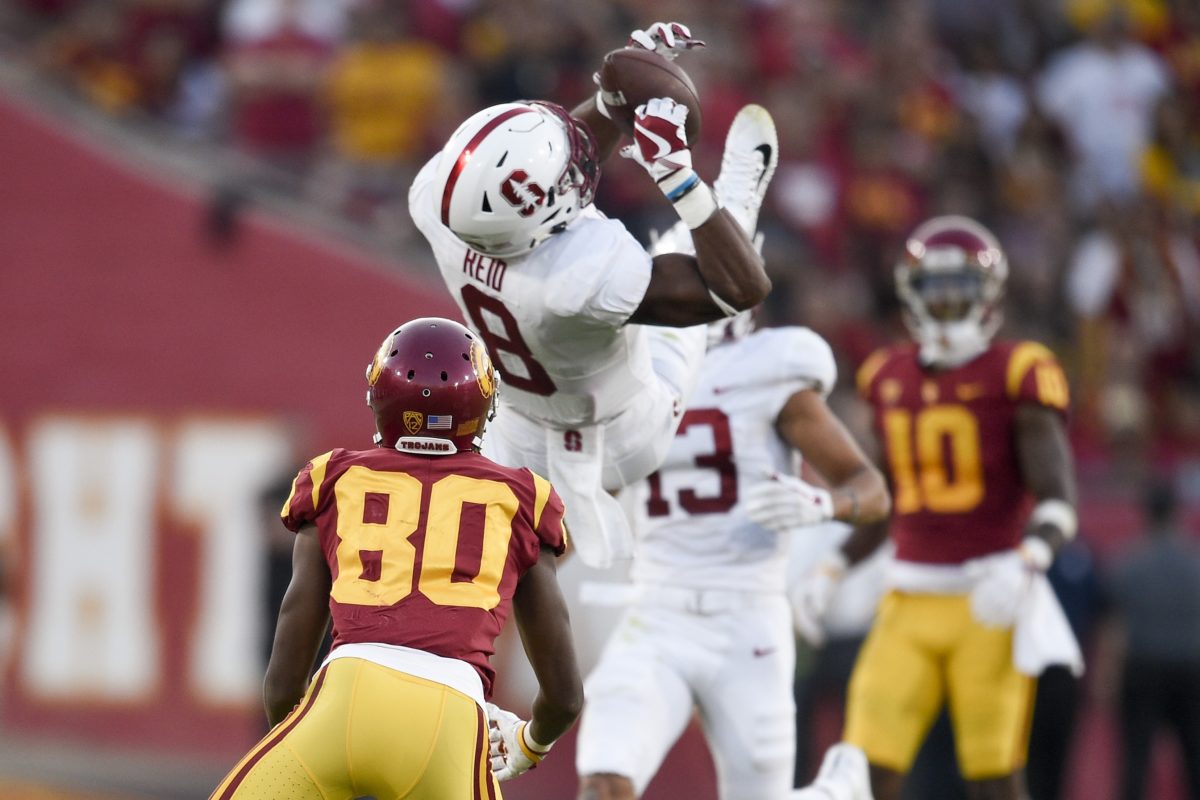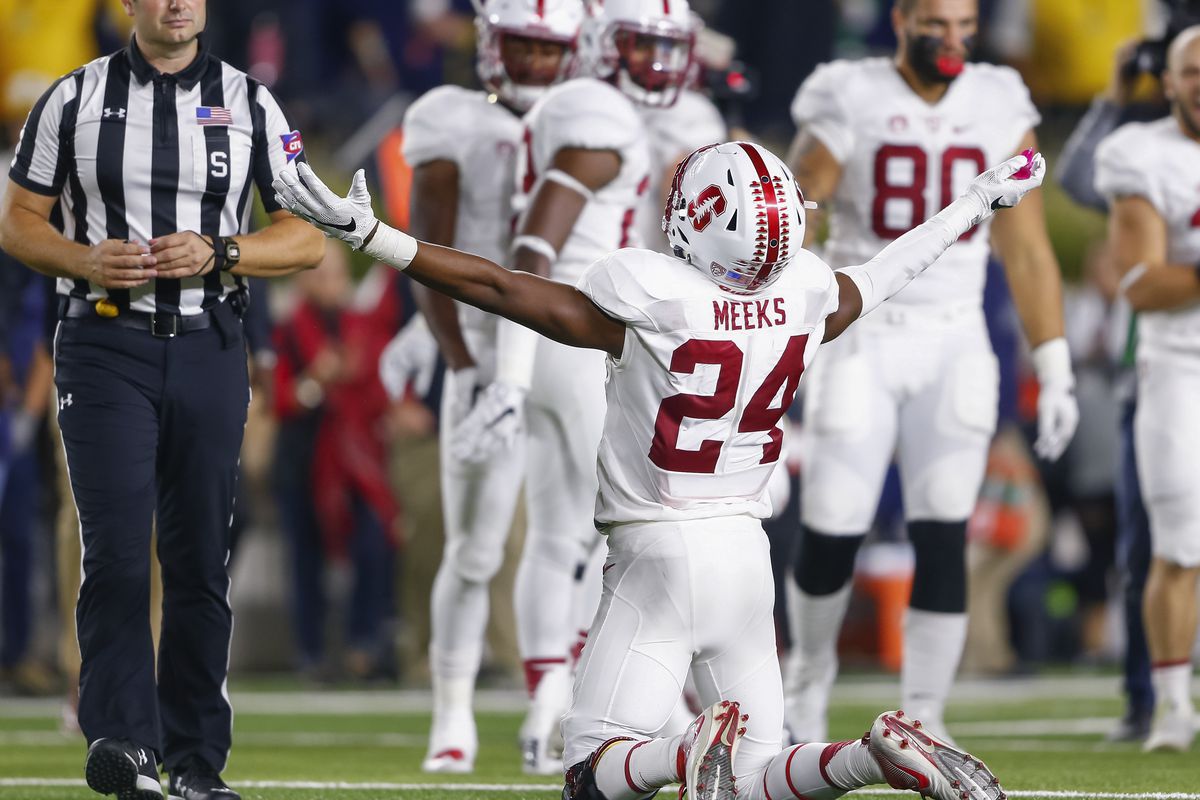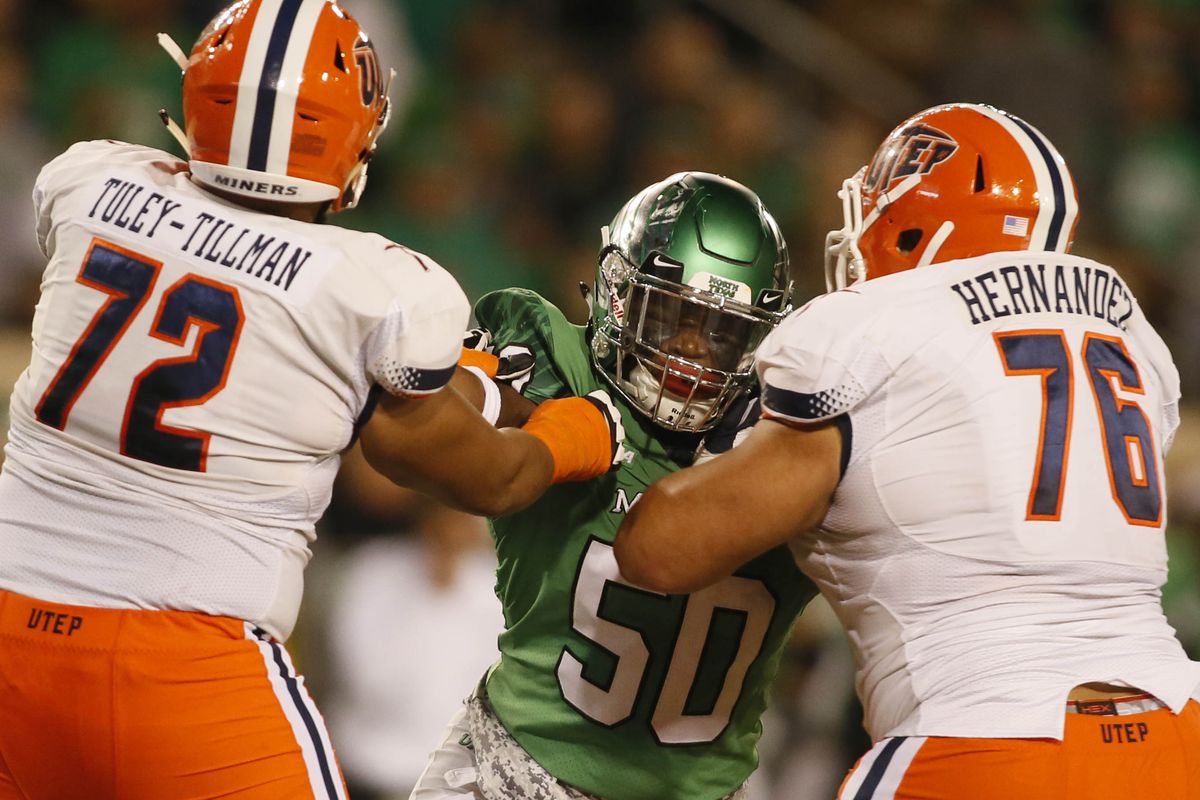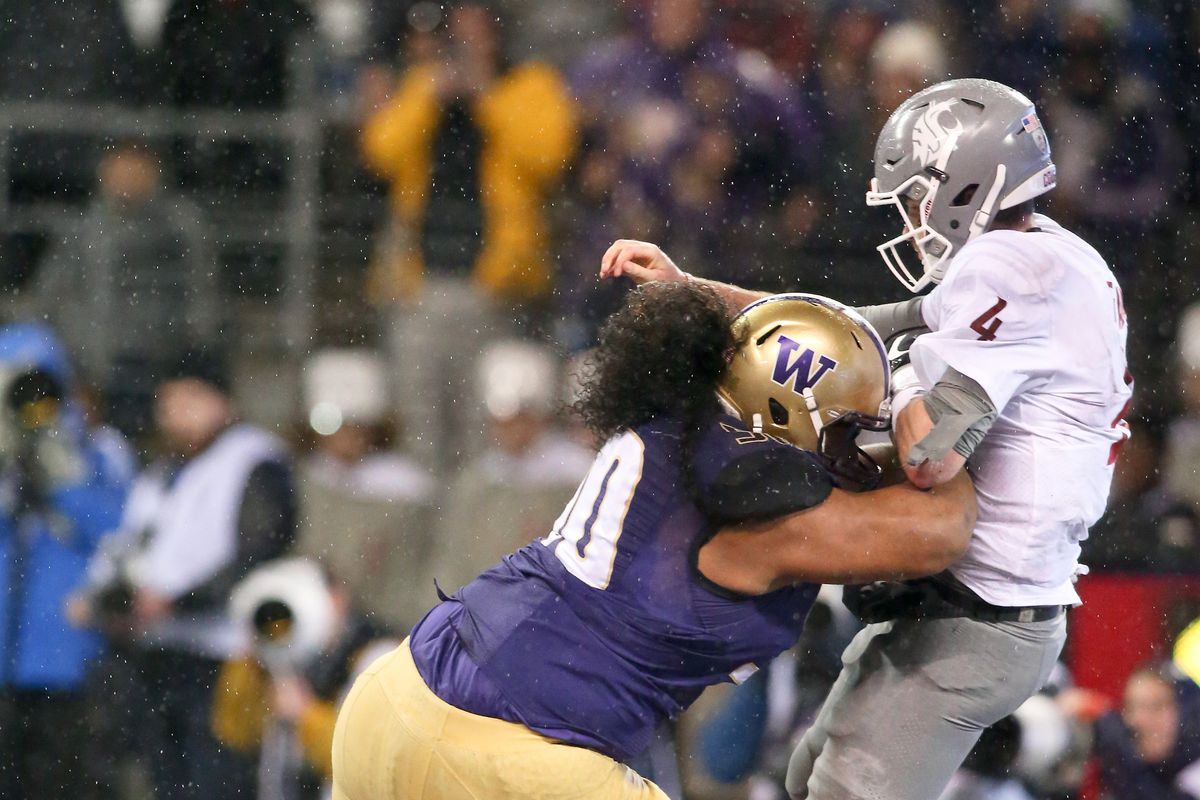Second Round Grades
Nick Chubb, HB Georgia
As a pure ball carrier, Chubb is possibly the best player in the class. He runs with good vision, quickness and power and should be a feature player at the next level. First-rounder Saquon Barkley’s value is massively boosted by his receiving ability and this is an area where Chubb will need to prove himself to NFL scouts, as while he showed decent hands in college, he was barely used as a receiver at Georgia. For a team looking for an inside power runner, Chubb is a perfect fit, and it is only his receiving ability that keeps him out of the first round. For a more complete evaluation please see the Scout Camp profile.

Justin Reid. Photo Credit: Kelvin Kuo-USA TODAY Sports
Justin Reid, FS Stanford
There is an awful lot to like about Reid on tape, as he flashes athleticism, ball skills and an intelligent scheme understanding. However, he is also prone to the simple mental lapses that will drive defensive coordinators mad; if he can use his football intelligence to play within the confines of the defense, he could be a valuable playmaker on the back end, but that risk is what drops his value out of the first round. For a more complete evaluation, please see the Scout Camp profile.
Da’Ron Payne, DT Alabama
Payne was a well-established run-stuffer coming into the 2017 season, but flashes of pass rushing potential have caused his draft stock to rise to that of a potential three-down interior defensive lineman in a 4-3 defense. Not only is he athletic, but he uses his hands well in both the rushing and passing games; this allows him to be a frequent fixture in the backfield. He will need to work on his pad level in order to maximize his potential, but there is enough to like on tape to have him ranked this high.
Calvin Ridley, WR Alabama
This is not an especially good receiving class, but Ridley is the best of a mediocre bunch. He flashes excellent route running, good deep speed and nice hands, with the ability to make some plays after the catch. While his route running is extremely good, he didn’t run a full route tree at Alabama, as few receivers in college do; it will be interesting to see if he is able to take his understanding of how to use routes to get open and apply it to a broader range. He is one of only a handful of receivers in this draft to offer #1 WR potential, and also has a higher floor than most.
Derwin James, SS Florida State
Derwin James is the player for the modern NFL, he can line up everywhere from a 3-4 OLB to a free safety and has the size/speed combination to offer a huge amount of flexibility for defensive coordinators. However, there are some concerns, especially in zone coverage where his awareness and lateral agility are a slight cause for alarm, and while his versatility is hugely valuable, it will also pose a problem for defensive coordinators in terms of maximizing his ability. His ceiling is huge, but it isn’t quite clear quite how valuable he will be at the NFL level.

DaeSean Hamilton at the NFL Combine.
DaeSean Hamilton, WR Penn State
Hamilton is unlikely to ever develop into a #1 WR at the NFL level, but he is the most pro-ready route runner in this draft class and offers the ability to be an immediate contributor as a possession receiver who can line up either outside or in the slot. He won’t be hugely effective at stretching the field, but if you are looking for somebody to throw the ball to on third-and-medium, Hamilton shows the ability to separate underneath with good hands and even some run-after-catch ability. For a more complete evaluation, please see the Scout Camp profile.
DJ Moore, WR Maryland
While Hamilton offers immediate pro-ready value, Moore offers more potential reward, just with a higher risk attached. Moore’s 2016 tape is especially impressive, as here he shows the ability to create separation with exceptional changes of direction while maintaining momentum through his cuts. Maryland didn’t really have a quarterback in 2017, and Moore’s game became more focused on screens and fades; what is concerning with Moore on tape is the inconsistency, and while he flashes the kind of route running that could make him an elite NFL WR, there are times where he appears to be simply going through the motions. A true gamble as a prospect. For a more complete evaluation please see the Scout Camp profile.
Kendrick Norton, 3-4 DE Miami
Norton is another risk-reward prospect, as while he flashes huge potential on tape, there are irritating inconsistencies. His quickness and ability to penetrate on regular basis could make him extremely valuable in defensive schemes that focus on disruption in terms of defensive line play. If he can play with more consistent leverage, he could be an ideal fit for teams that look for a Sheldon Richardson-type defensive penetrator.
Derrius Guice, HB LSU
At his best, Guice is a wrecking ball rusher who gets downhill quickly and shows an excellent ability to extend runs once he gets to the second level. As with Chubb, he will need to show more as a receiver at the NFL level, but as a runner, his biggest question marks relate to his ability to read running lanes on a consistent basis. Best suited to a downhill running scheme that will allow him to hit a hole with speed, Guice is at least competent when asked to read zone running lanes, but this fails to make the most of his chaotic running style. Injury concerns from 2017 might also be a factor for some teams. For a more complete evaluation, please see the Scout Camp profile.

Quenton Meeks. Photo Credit: Michael Hickey/Getty Images
Quenton Meeks, CB Stanford
As with Josh Jackson, Meeks is likely a zone corner at the NFL level with the ability to play some man as well. He doesn’t have the same elite movement skills as Jackson and will struggle against receivers with elite speed, but flashes the awareness, ball skills and run defensive skills to be a good outside corner on a zone-heavy team. He will be limited in terms of scheme and match-ups, but should be an immediate starter on most zone-based teams. For a more complete evaluation, please see the Scout Camp profile.
Arden Key, EDGE LSU
The upside with Key is enormous, as a sophomore in particular, he flashed the kind of speed off the edge to give offensive tackles fits. What is also true, however, is that his college career has not been an uneventful one, with him retiring briefly as a junior and his weight varying by almost 50 pounds over the course of his junior season. It probably didn’t help that LSU insisted on using him in coverage a high proportion of the time, and his junior tape is almost useless when it comes to projecting him to the NFL. The risk with Key is enormous, but so is his ceiling. For a more complete evaluation, please see the Scout Camp profile.
Frank Ragnow, C/G Arkansas
Ragnow has quietly been excellent for Arkansas in recent years and his ability in space speak to a sneaky athleticism. He also has the power and body control to suit multiple run schemes with the feet to be a top-tier pass protector; all that is keeping him out of the first round is his inconsistent pad level, which can lead to him being jacked up at times against more disciplined defensive linesmen. If he can get this under control, he could be a quality starter for the next decade. For a more complete evaluation, please see the Scout Camp profile.
Dallas Goedert, TE South Dakota State
Whereas Andrews is more in the mold of Greg Olsen or Travis Kelce, Goedert is built more like Gronk. He doesn’t show the same route running nuances at Andrews, but is simply able to use his frame to create separation at the head of the route. while offering the power to be a genuine factor in the running game as well. He will need to develop more as a route runner and the lower level of competition makes it hard to judge quite how good he is, but the matchup potential is huge. For a more complete evaluation, please see the Scout Camp profile.
Maurice Hurst, DT Michigan
There is very little not to like about Hurst, as he has very few weaknesses on tape. In that regard, his floor is extremely high, but his ceiling is somewhat more uncertain. While he is a good athlete, he doesn’t flash the quickness and power to be hugely effective as a penetrator and while his hand usage is decent, he doesn’t show the elite hand usage that will be needed in order to be a persistent difference maker at the NFL level. If he can improve in this area in order to create more negative plays, he shows the ability to be a three-down difference maker at the NFL level.
Leighton Vander Esch, LB Boise State
As with Hurst, Vander Esch has a good all around game without the obvious upside to merit a top pick. He plays well against the run in terms of angles and the ability to work through traffic, and enough coverage ability in zone to be seen as a three-down linebacker at the NFL level. He will need to show the ability to cover running backs and tight ends in man coverage in order to make the step to the next level, but is probably the most complete linebacker in the draft.
Kemoko Turay, EDGE Rutgers
Turay is another risk-reward player who looks to make the move from a 3-4 OLB to a 4-3 DE at the NFL level. He is a good athlete but his real value comes in his good pad level and hand usage which allow him to work effectively around the edge. He will likely need to add some strength in order to anchor against the run at the next level but in a draft short of edge rushers, he offers a nice combination of technique and athleticism.

Will Hernandez. Photo Credit: Tim Heitman/USA TODAY Sports
Will Hernandez, G UTEP
Hernandez is somewhat in a throwback, both in terms of his enormous neck brace and his powerful playing style. He is a decent pass protector but his real value comes in the running game, where he looks to be an ideal fit for any team that wants to run a power running game. Teams that run a more zone-based rushing game will want to see a greater understanding of leverage and better body control in order to maximize his athleticism, but as it stands, his current level offers sufficient value to make him a second-round prospect who will likely be selected in the late first round.
Duke Ejiofor, DE Wake Forest
Ejiofor might not flash the elite athleticism often associated with top DE prospects, but his technique is excellent. He uses his hands better than any defensive line prospect in recent memory and this allows him to be a regular feature in the backfield despite not being a dominant athlete. This allows him to be extremely effective against the run where he was able to penetrate gaps with frightening consistency; he might never become a dominant pass rusher, but he offers enough in this regard for teams to view him as a legitimate starting defensive end at the NFL level. For a more complete evaluation please see the Scout Camp profile.
DeShon Elliot, SS Texas
Elliot is more of a conventional strong safety compared to Derwin James, and while he doesn’t flash the same matchup potential, he is a good athlete with the ability to cover tight ends and running backs in man coverage along with the ball skills to offer upside as a zone defender on the back end. He will need to be more disciplined in zone coverage in order to avoid giving up big plays, but could be a quality starter early on in his NFL career.
Anthony Miller, WR Memphis
Miller is something of a peculiarity as a receiver prospect, as while he lacks the size and ability in the air for many teams to view him as a true #1 WR, he actually has a very well-rounded game with good route running and the ability to make plays after the catch. He didn’t run a complete route tree at Memphis and this will always be a concern for NFL teams; not to mention his size and lack of proven ability against press could make him a mainly slot-limited player at the NFL level. If teams are convinced that his route running ability will apply to a wider route tree and that he can function against press then they could well have him higher on their draft boards than this.
Take all of these grades with a grain of salt; players with a second round grade will almost certainly be selected in the first round and a player like Benkert will likely still be available on Day 3. These are grades of the players as prospects and how they might translate to the NFL rather than where I expect them to be drafted; as always, scouting is a subjective science.



